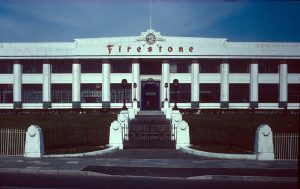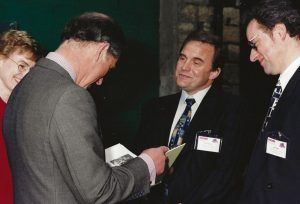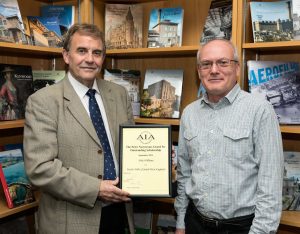In 1973 I was appointed to the first AIA Council and now 50 years later, after some gaps in my Council membership, I am currently on the Council as Chairman.
Born in 1946, I was brought up and educated in Edinburgh though spent the summer holidays on my grandfather’s farm in rural Aberdeenshire. Those were the days of binder-reapers, horse pulled carts and electric generators – an early introduction to farming heritage. Edinburgh was somewhat more civilised. From the age of four years old, I travelled on the jolting No. 5 tram to school each day – a truly unforgettable transport experience. The Royal High School on Calton Hill overlooked the Holyrood Brewery where I was to spend my four summer holidays from Edinburgh University working cooling plants and cleaning beer vats and where my interest in brewing was easily developed.
From 1964 my Geography MA Honours degree was to prove formative in my later career, as I took Archaeology, Geology and History of Architecture as my outside subjects while my dissertation was on the Aberdeenshire Canal. The upper of the canal survived as a feeder to the steam-driven Tait’s Paper mill at Inverurie and that encounter was to encourage me in 1968, funded by a three-year SSRC Grant, to undertake postgraduate research at Hull University to ascertain what had happened to abandoned canals throughout mainland Britain. As a part-time tutor, I was also to take students on various residential field trips to study the industrial archaeology of Shropshire and Midlothian. These encounters with the industrial heritage were to prove instrumental in landing the job as CBA Industrial Monuments Survey Officer in 1971.
The CBA had championed industrial archaeology since 1959 and in 1963, on receipt of a grant from the Inspectorate of Ancient Monuments, had appointed a part-time consultant to its Industrial Monuments Survey, informed by CBA field cards which then formed the National Record of Industrial Monuments (NRIM) based at Bath University from 1965. In 1971, the funding was increased to employ a full-time Survey officer reporting to the CBA Panel on Industrial Archaeology, which had been formed in 1967 to make recommendations for protection, recording and museum preservation. The Appointment Board comprised from the CBA Research Committee on Industrial Archaeology included Angus Buchanan, Neil Cossons and Peter White all of whom were to very influential in the development of the subject and become close friends for the next forty years.
Based with Angus Buchanan at Bath University, as Survey Officer for the next ten years, I travelled the length and breadth of the country visiting several thousand sites and acting as the conduit between local and thematic expertise and official bodies. I also represented the CBA at public enquiries into the proposed demolition of prominent industrial sites including the Sheerness Boat-store (lost) and the North Warehouse Gloucester Docks, Howard Street Warehouse Shrewsbury and Curzon Street Station, Birmingham (all saved).

In 1981 I was taken on to the Royal Commission on the Historical Monuments of England’s staff, the change in management was partly prompted by the national outrage at the demolition of the central bays of the iconic 1928 Firestone Building in London. The demolition, over the 1980 August Bank Holiday immediately prior to the building being Listed, had exposed the slow progress of the national protection programmes generally and the Secretary of State demanded an Accelerated programme involving a twelve-fold increase in contract staff. Henceforth, I was to advise Listing Officers on the merits of historic industrial sites, undertake and oversee the RCHME recording of threatened industrial sites and advise a programme of publications on historic industrial sites.
Over the next 20 years the RCHME output of such books starting in 1980 with modest publications such as on Liverpool Street Station Manchester and Frome’s Industrial Housing was to encompass the entire breadth of England’s industrial heritage – the textile mills of West Yorkshire, Manchester and Cheshire, Liverpool’s Historic Waterfront and other docklands, the Royal Naval Dockyards, Staffordshire’s potteries, Cumbrian ironworks and gunpowder mills, Cornish mining, coal mining, farming and my own Swindon: the Legacy of a Railway Town written with John Cattell.

In 1989 when the RCHME was to move out of London in the late 1980s, I initiated the move to the GWR Office Building at the former Swindon Railway Works – now Historic England’s national office with its linked Archive Building. My work was to take a further step with the development of the 1999 UK Tentative List of World Heritage Sites. A shortlist of industrial sites was proposed and this involved visiting all the sites, outlining their possible boundaries and writing summary entries for the Tentative List. Somewhat later, with the successful Inscription of most of these WHS, I was asked to advise on some WHS abroad including the Basin Miniere coalfield in northern France, the Tomioka Silk Milll in Japan and Fray Bentos Anglo Factory and Settlement in Uruguay
With the merger of the RCHME and English Heritage in 2000 I had additional responsibilities for military matters and the increased involvement in Naval Dockyards, wartime airfields and sites such as Bletchley Park was a delight. I now was also involved with English Heritage’s European projects such as Historic Airports, European Common Inheritance and Working Heritage. The publication side also flourished with English Heritage authors, over the last two decades, winning many of the AIA Publication Awards including five Outstanding Scholarship Awards.

One of my last tasks before I retired in 2012 was, with Shane Gould, to advise on the Industrial Buildings @ Risk project and this led to Industrial Heritage Support Officer project being based at Ironbridge and that project is still supported by the AIA.

Upon retirement, freed on any conflict of interest, I joined the AIA Council as Vice-Chairman and was subsequently Chairman from 2014 -2017. In 2013, I was very proud to be awarded an OBE in the Queen’s Birthday Honours List for services to the industrial heritage
For the last five years I have very much enjoyed my role as Coordinator of the Restoration Grants Panel. Thanks to our Anonymous Donors, the AIA, by awarding more than £1 million over the last decade, has been able to make a truly significant contribution to preserved sites across the country.

